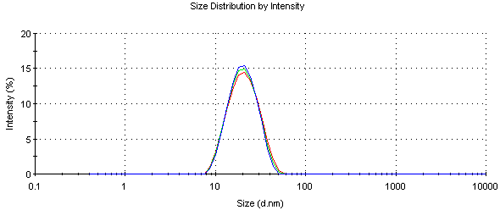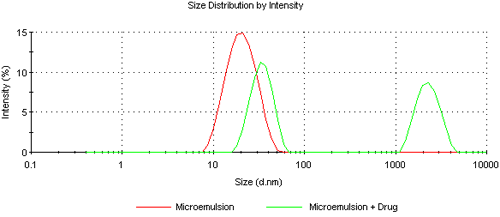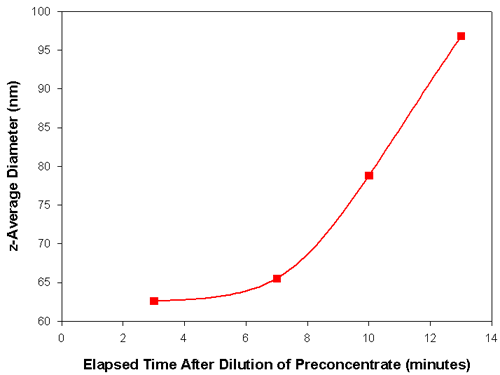Microemulsions have attracted large interest in the pharmaceutical industry as drug delivery systems due to their improved drug solubilization properties, increased shelf life and ease of preparation. They normally consist of an aqueous phase, an oil phase, a surfactant and a co-surfactant (usually an alcohol). When the concentrations of these components are favorable, they spontaneously emulsify to form a monodisperse, thermodynamically stable, transparent microemulsion.
Many drugs that are insoluble in aqueous media are prepared as preconcentrates consisting of oil, surfactant and alcohol. This is then diluted with water to form the microemulsion prior to administration to the patient.
Size characterization of the resulting microemulsion is essential in ensuring safe and efficient dosage. Monitoring changes in the size distribution can provide valuable information for optimizing the formulation.
Dynamic light scattering (DLS) is a technique for measuring the particle size of colloidal suspensions. In DLS, the sample is illuminated with a laser beam and the intensity of the resulting scattered light produced by the particles fluctuates at a rate that is dependent upon the size of the particles. Analysis of these intensity fluctuations yields the diffusion coefficient of the particles and hence the particle size. Further information on the technique of dynamic light scattering can be found on the Malvern web site.
The measurements shown in this application note demonstrate the use of DLS for studying the effect of incorporation of drug into a microemulsion and the time-dependent loss of drug solubility.
Measurements were made on a Zetasizer Nano ZS instrument at 25°C. The instrument contains a 4 mW He-Ne laser operating at a wavelength of 633 nm and incorporates non-invasive backscatter optics (NIBS). The measurements were made at a detection angle of 173° and the measurement position within the cuvette was automatically determined by the software.
The preconcentrate formulations were diluted in deionized water to form the microemulsion.
Figure 1 shows the intensity size distributions obtained from three repeat measurements of the microemulsion. This sample did not contain any drug material. The results show very repeatable intensity size distributions with z-average diameters of 18.9nm. The z-average diameter is the mean hydrodynamic diameter and is calculated according to the International Standard on dynamic light scattering ISO22412.

|
Figure 2 shows the intensity size distribution of a microemulsion obtained by dilution of a preconcentrate formulation in deionized water. This sample contains an oil-soluble drug. The first peak at around 30nm arises from the microemulsion droplets. The peak positioned at 2 microns arises from insoluble drug leaking out of the microemulsion. The presence of the second peak has resulted in the z-average diameter for this sample increasing to 63nm.

|
When one of the intensity size distributions shown in figure 1 is over-plotted with the one shown in figure 2, the effect of the incorporation of the drug on the particle size of the microemulsion droplet can be clearly seen (figure 3). The peak due to the microemulsion droplet has increased in size due to the solubilization of the drug molecules.

|
Monitoring of the z-average diameter as a function of elapsed time since the formation of the microemulsion by dilution of the preconcentrate, allows the study of any loss of drug solubility. This information is invaluable in adjusting the formulation of the preconcentrate to maximize the solubility of the drug in the resulting microemulsion. The z-average diameter is intensity weighted and is therefore sensitive to the presence of large particles. It is a suitable parameter for following processes such as particle aggregation or crystallization.
Figure 4 shows the increase in the z-average diameter as a function of the elapsed time since the formation of the microemulsion by dilution of a preconcentrate containing an oil-soluble drug. This increase in the mean diameter results from the gradual loss of drug solubility from the microemulsion droplets. Suitability of various preconcentrates for maximizing drug solubility can be investigated by monitoring changes in the z-average diameter.

|
Dynamic light scattering is a non-invasive technique well suited to the study of colloidal dispersions such as microemulsions. The suitability of microemulsions for the solubilization of drugs can be determined by following changes in the size distributions and mean diameters with time.